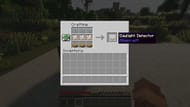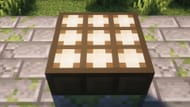Redstone is one of Minecraft's largest and most complex items. Players have used it to create large and impressive automated farms, other video games, such as Pokemon, and even full computer processors. One of the most conceptually interesting of the many redstone components that players have access to is the daylight sensor.
Everything you need to know about these, from how to craft them to their uses and more, can be found detailed below.
All about Minecraft's daylight detector
The recipe

Chart New Territories with the ultimate Minecraft Seed Generator!
Daylight detectors have quite a simple recipe. To craft it, place three glass in the top row of the crafting interface, three quartz in the middle, and three wooden slabs at the bottom. Since these detectors need quartz, you will require access to Minecraft's Nether before you can craft them.
Uses

Since a daylight sensor is a redstone component, its primary use is within larger Minecraft redstone machines. This is a power block that is able to produce a redstone signal of various strengths depending on the time, weather, and internal sky-light level.
The default formula for determining an output signal's strength is incredibly complex, to the point of being needlessly confusing. The important thing to note about the block is that, on a clear day, it produces a signal of 0 at midnight and 15 at noon.
The length of time that the detector emits a signal of any particular strength increases as the day approaches noon. For example, the sensor only outputs a signal of one for 450 game ticks but will produce a signal of 15 for 3,410 ticks.
The weather has a significant impact on the daylight detector's ability to emit a redstone signal. In rain or snow, a maximum power of 12 can be produced by this block. This cap is even lower during thunderstorms, which limit the daylight sensor's signal strength to 10.
It's worth noting that light-producing blocks, such as torches, lanterns, or glowstone, are not able to activate a daylight detector. They will produce a Minecraft redstone signal only when illuminated by the sun.
Players can invert daylight detectors by interacting with them again once they are placed. This causes them to output a signal based on how dark it is. The formula to determine an inverted daylight detector's output is much simpler. It simply produces a signal of strength 15 minus the current internal sky-light level.
Other daylight detector information

You can break and collect daylight sensors without any particular item, but the fastest way to do so is with an axe.
While not the best use of this item, it can act as Minecraft furnace fuel in a pinch. The furnace will only smelt 1.5 items per daylight sensor used, which is why the detector should only be burned as a last resort.
Lastly, the detectors will also cause note blocks to produce "bass" sounds.
Uncover new worlds with our Minecraft Seed Generator!

